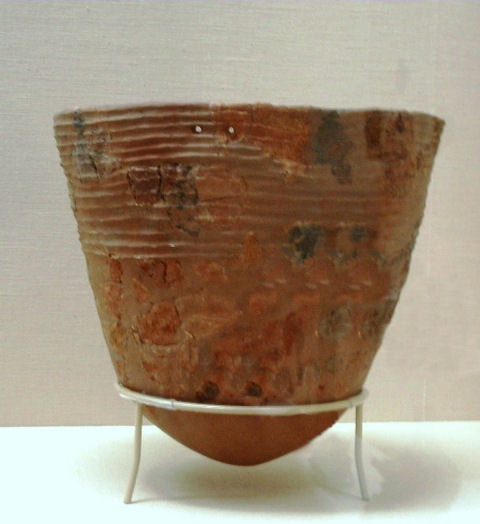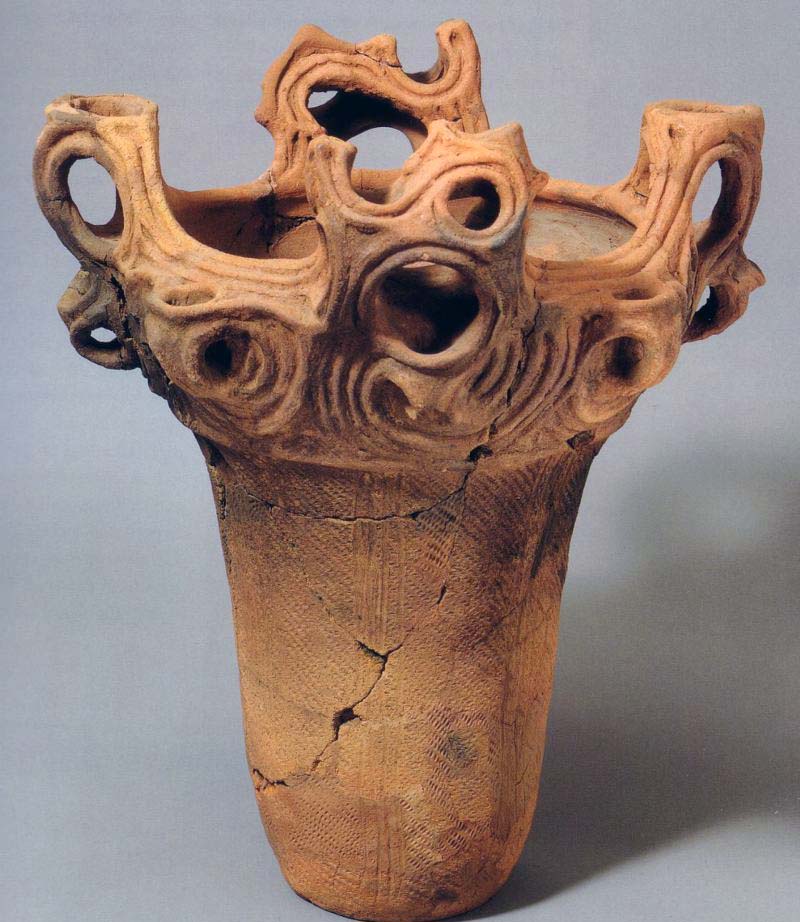Humans had lived in Japan from about 30,000 B.C. Japan was not always an island. During the Ice Ages, it was connected to the Korean peninsula by means of a land bridge. All four main Japanese islands were connected, and the southern island of Kyushu was connected to the Korean peninsula while the northern island of Hokkaido was connected to Siberia. Paleolithic humans crossed this land bridge in much the same way they crossed the Bering land bridge into the Americas. It was probably around 30.000 B.C. from the flint tools that they left behind.
Then around 10.000 B.C., these original inhabitants developed a unique culture which lasted for several thousand years: the Jomon culture. As with all preliterate people, all we know of them comes from fragments of artifacts and the imaginative guessing of anthropologists and archaeologists. Jomon means “cord pattern,” for these people designed cord patterns on their pottery—the oldest of its kind in human history. Pottery, however, is a characteristic of Neolithic peoples; the Jomon, however, were Mesolithic peoples (Middle Stone Age). All the evidence shows that they were a hunting, gathering, and fishing society that lived in very small tribal groups. But in addition to making pottery, they also fashioned mysterious figurines that appear to be female. An ancient goddess worship?
Jomon culture can be divided into six separate eras. These eras are the: Incipient, Initial, Early, Middle, Late, and Final Jomon periods.
Incipient Jomon
The Incipient Jomon, which is dated from about 10.500 B.C. to 8.000 B.C. Human left us only pottery fragments. These pottery fragments were made by a people living in the Kanto region on the eastern side of Honshu, the plain on which today’s Tokyo is located. The Incipient Jomon pots are a major challenge to understanding human cultures, for they represent the very first ceramics in human history, predating Mesopotamian ceramics by over two thousand years.



The standard anthropological line on the development of human arts asserts that pottery-making developed after agriculture and is characteristic of a more sedentary culture. The Incipient Jomon, however, were hunter-gatherers who lived in nomadic small groups. Yet they developed the art of pottery long before agriculture was introduced into Japan—in fact, the Incipient Jomon invented pottery-making long before any human was introduced to agriculture. The Incipient Jomon, then, demonstrate that pottery-making is a human technology independent and distinct from agriculture.
Initial and early Jomon
The Initial Jomon, which lasted from 8.000 B.C. to 5.000 B.C. is distinguished by the fact that pretty complete pots that were used to boil food. Like the fragments from the Initial Jomon, these aren’t just plain old pots, but are intricately decorated in the “cord-like” structure that characterizes Jomon.
The Early Jomon, from 5.000 to 2.500 B.C., corresponds to the single most interesting couple thousand years in human history. At the end of the last ice age, around 14.500 years ago, the world began to slowly warm. Between 5000 and 2500 B.C., the world reached its warmest in the millennia following the ice age—during this period, the average global temperature was about four to six degrees Fahrenheit higher than it is today. Never again would the world be as warm as it was in these two centuries. Corresponding the steady warming of the earth was the development of agriculture, the single most important technological invention of human beings. Corresponding the warmest period since the last ice age were tremendous innovations in human habitation.



It was in this period that human beings all over the world began to live in a more sedentary manner—at the beginning of this period, human beings begin to live in substantially sized villages; towards the end of this period, the very first human cities appear. The Jomon were no exception to this world-wide phenomenon. Completely cut off from all other humans, the Jomon also began to live in large villages in a settled lifestyle. These villages consisted of large pit-houses; the floors of these houses are about a foot below ground level. It seems they lived in extended family groups. The Jomon also developed their pottery work even further: they began to fashion figurines. It’s not clear what they are, animal or human, but they are the first Japanese sculptural art.
Middle Jomon
In the Middle Jomon, from 2.500-1.500 BC., humans from the Jomon culture migrated from the Kanto plain into the surrounding mountainside. While the Old Kingdom Egyptians were building pyramids, the Yellow River kings developing the first centralized states in China, and the Sumerians building the very first urban centers, the Jomon, who had no awareness of people off their island, began to live in very large villages and developed very simple agriculture or proto-agriculture. They were no longer hunter-gatherers, but rather a skilled and settled people that developed increasingly sophisticated artwork with magnificent decorations. Their figurines now distinguish between animals and humans, and their human figurines have tantalizing but perplexing gestures whose meaning is now lost to us.
Late and Final Jomon period
The Late (1500-1000 BC) and Final (1000-300 BC) Jomon corresponded to the neoglaciation stage in modern climactic history. The world cooled noticeably (colder than today), and the Jomon migrated back down to the Kanto region. At this point, the Jomon developed an identifiable religion—they produce a remarkable number of figurines and stone circles constructed outside the main villages begin to appear. The figurines they produce are largely heavy female figurines which suggests that the Jomon religion was a goddess religion.
